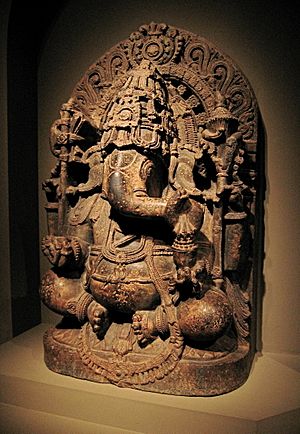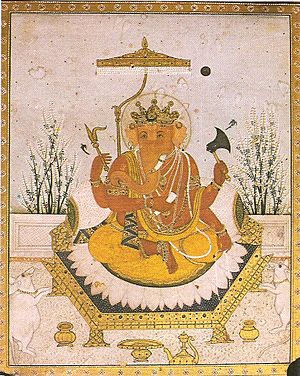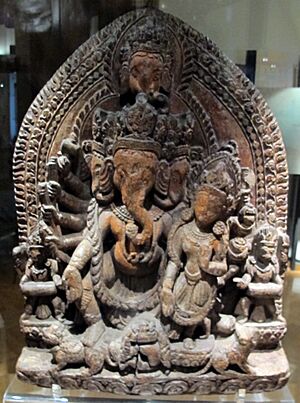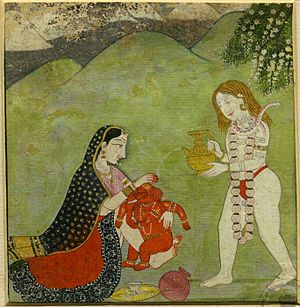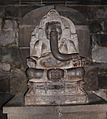Ganesha facts for kids
Quick facts for kids Ganesha |
|
|---|---|
| God of Luck and New Beginnings Remover of Obstacles Supreme God (Ganapatya) |
|
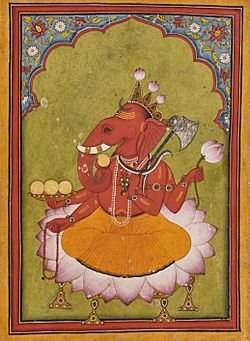
Basohli miniature, c. 1730. National Museum, New Delhi.
|
|
| Affiliation | Deva, Brahman (Ganapatya), Saguna Brahman (Panchayatana puja) |
| Abode | • Mount Kailash (with parents) • Swanandhlok |
| Mantra | Oṃ Ekadantaya Vidmahe,Vakrathundaya Dhimahi,Thanno Danthi Prachodhayat Oṃ Shri Gaṇeśāya Namaḥ Oṃ Gaṃ Gaṇapataye Namaḥ |
| Weapon | Paraśu (axe), pāśa (noose), aṅkuśa (elephant goad) |
| Symbols | Swastika, Om, Modak |
| Mount | Mouse |
| Texts | Ganesha Purana, Mudgala Purana, Ganapati Atharvashirsa |
| Gender | Male |
| Festivals | Ganesh Chaturthi, Diwali |
| Personal information | |
| Consort | Riddhi and Siddhi or celibate |
| Parents | |
| Siblings | Kartikeya (brother) |
| Equivalents | |
| Buddhists equivalent | Kangiten |
Ganesha (Sanskrit: गणेश, IAST: Gaṇeśa) is a very well-known and loved god in Hinduism. He is also called Ganapati, Vinayaka, and Pillaiyar. Many people worship him as the Supreme God in the Ganapatya tradition.
You can find images of Ganesha all over India. People also worship him in countries like Nepal, Sri Lanka, Thailand, Indonesia, Singapore, Malaysia, and Bangladesh. He is also popular in countries with many people of Indian heritage, such as Fiji and Mauritius.
Ganesha is easy to spot because of his elephant head. He is known as the god who removes problems and brings good luck. He is also the patron of arts and sciences, and the god of wisdom. Because he is the god of new beginnings, people honor him at the start of ceremonies. Ganesha is also asked for help with writing and learning.
Contents
Ganesha's Many Names
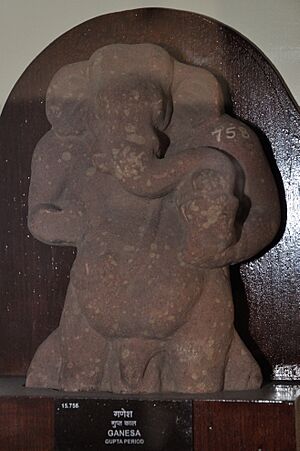
The name Ganesha comes from two Sanskrit words. These are gana (gaṇa), which means 'group' or 'multitude', and isha (īśa), meaning 'lord' or 'master'.
So, Ganesha means "Lord of the Ganas." The Ganas are a group of semi-divine beings who are part of Shiva's followers. Shiva is Ganesha's father.
Some people also understand "Lord of the Ganas" to mean "Lord of Hosts." This can also mean "Lord of created things," like the elements.
How to Recognize Ganesha
Ganesha is a very popular figure in Indian art. You can see him in many different ways. He might be shown standing, dancing, or fighting demons.
Sometimes he is shown playing with his family as a boy. He can also be sitting on a special seat. In very rare cases, he might even have a human head.
Special Features of Ganesha
Ganesha has always been shown with an elephant head in Indian art. There are many stories about how he got his elephant head.
One common story says that Ganesha was made by Parvati from clay. She made him to protect her. When Shiva tried to see Parvati, Ganesha stopped him. Shiva then cut off Ganesha's original head. Shiva then replaced it with an elephant's head.
Another story says that Shiva created Ganesha directly from his laughter. Shiva then gave him an elephant head and a large belly.
Ganesha's earliest name was Ekadanta, which means "One Tusked." This is because one of his tusks is broken. Some of the oldest pictures of Ganesha show him holding his broken tusk.
Ganesha can have different numbers of arms. Most often, he has four arms. Some people think his trunk is like a fifth arm.
A snake is often seen with Ganesha. Sometimes it is wrapped around his neck, like the serpent Vasuki. Other times, it is used as a sacred thread or a belt around his stomach. It can also be held in his hand or coiled around his ankles.
Ganesha is often shown as red in color. He might also have a third eye or a special mark called a tilaka on his forehead.
Ganesha's Powers
Removing Obstacles
Ganesha is known as Vighneshvara. This means "Lord of Obstacles." He is widely worshipped as someone who removes problems. However, he can also place obstacles in the way of those who need to be stopped. People often worship him before they start anything new.
God of Wisdom
Ganesha is also seen as the Lord of letters and learning. The Sanskrit word buddhi means intelligence or wisdom. This idea of buddhi is strongly linked to Ganesha. Many stories show how clever and wise he is.
Ganesha's Family
Ganesha is usually known as the son of Shiva and Parvati. But old texts called the Puranas tell different stories about his birth. In some stories, Parvati created him alone. In others, Shiva and Parvati created him together.
Ganesha has a brother, the god of war, Kartikeya. He is also called Skanda. In northern India, Skanda is often said to be the older brother. But in southern India, Ganesha is usually considered the firstborn.
Ganesha's marital status changes in different stories. In some myths, he is a single brahmachari (unmarried). This idea is common in southern India. In other stories, he is linked with the goddesses Buddhi (intellect), Siddhi (spiritual power), and Riddhi (prosperity). These goddesses are sometimes said to be his wives.
He is also sometimes linked with the goddess of arts, Sarasvati. And he is associated with Lakshmi, the goddess of luck and wealth.
The Shiva Purana says that Ganesha had two sons: Kşema (safety) and Lābha (profit). In northern India, his sons are often called Śubha (goodness) and Lābha.
Worship and Festivals
People worship Ganesha on many religious and everyday occasions. This often happens at the start of new things, like buying a car or starting a business. Followers believe that if Ganesha is happy, he will bring success and protection.
People offer Ganesha sweets like modaka and laddus. He is often shown holding a bowl of sweets. Because he is linked with the color red, he is often worshipped with red sandalwood paste or red flowers. Special grass called Dūrvā is also used in his worship.
Two main festivals are linked to Ganesha. One is Ganesha Chaturthi, which happens in August or September. The other is Ganesh Jayanti, which celebrates Ganesha's birthday in January or February.
Ganesha Chaturthi
An annual festival honors Ganesha for ten days. It starts on Ganesha Chaturthi, usually in late August or early September. The festival begins with people bringing clay statues of Ganesha into their homes. This symbolizes the god visiting them.
The festival ends on the day of Ananta Chaturdashi. On this day, the statues are placed in a body of water, like a river or ocean. Some families do this on the 2nd, 3rd, 5th, or 7th day.
In 1893, Lokmanya Tilak helped make this festival a big public event. He was the first to put large Ganesha statues in public pavilions. He also started the tradition of putting all the public statues in water on the tenth day.
Today, Hindus all over India celebrate the Ganapati festival. It is most popular in the state of Maharashtra. It is also a very big event in Mumbai and Pune.
Ganesha Temples
There are many important Ganesha temples across India. Some well-known ones include:
- Siddhivinayak temple in Mumbai, Maharashtra.
- Ganpatipule temple at Ganpatipule, Maharashtra.
- Ujjain in Madhya Pradesh.
- Jodhpur in Rajasthan.
- Baroda in Gujarat.
- Dhundiraj Temple in Varanasi, Uttar Pradesh.
In southern India, famous Ganesha temples include:
- Kanipakam in Andhra Pradesh.
- The Rockfort Ucchi Pillayar Temple at Tiruchirapalli in Tamil Nadu.
- Kottarakkara in Kerala.
- Hampi in Karnataka.
Images for kids
-
Hindus in Ghana celebrating Ganesh Chaturti.
-
Street festivities in Hyderabad, India during the festival of Ganesha Chaturthi.
-
Ganesha statue in 9th-century Prambanan temple, Java, Indonesia.
See also
 In Spanish: Ganesha para niños
In Spanish: Ganesha para niños


